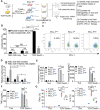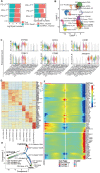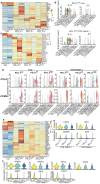Single-cell transcriptome analysis of the heterogeneous effects of differential expression of tumor PD-L1 on responding TCR-T cells
- PMID: 33754038
- PMCID: PMC7978322
- DOI: 10.7150/thno.55075
Single-cell transcriptome analysis of the heterogeneous effects of differential expression of tumor PD-L1 on responding TCR-T cells
Abstract
Rationale: TCR-T cell therapy plays a critical role in the treatment of malignant cancers. However, it is unclear how TCR-T cells are affected by PD-L1 molecule in the tumor environment. We performed an in-depth evaluation on how differential expressions of tumor PD-L1 can affect the functionality of T cells. Methods: We used MART-1-specific TCR-T cells (TCR-TMART-1), stimulated with MART-127-35 peptide-loaded MEL-526 tumor cells, expressing different proportions of PD-L1, to perform cellular assays and high-throughput single-cell RNA sequencing. Results: Different clusters of activated or cytotoxic TCR-TMART-1 responded divergently when stimulated with tumor cells expressing different percentages of PD-L1 expression. Compared to control T cells, TCR-TMART-1 were more sensitive to exhaustion, and secreted not only pro-inflammatory cytokines but also anti-inflammatory cytokines with increasing proportions of PD-L1+ tumor cells. The gene profiles of chemokines were modified by increased expression of tumor PD-L1, which concurrently downregulated pro-inflammatory and anti-inflammatory transcription factors. Furthermore, increased expression of tumor PD-L1 showed distinct effects on different inhibitory checkpoint molecules (ICMs). In addition, there was a limited correlation between the enrichment of cell death signaling in tumor cells and T cells and increased tumor PD-L1 expression. Conclusion: Overall, though the effector functionality of TCR-T cells was suppressed by increased expression percentages of tumor PD-L1 in vitro, scRNA-seq profiles revealed that both the anti-inflammatory and pro-inflammatory responses were triggered by a higher expression of tumor PD-L1. This suggests that the sole blockade of tumor PD-L1 might inhibit not only the anti-inflammatory response but also the pro-inflammatory response in the complicated tumor microenvironment. Thus, the outcome of PD-L1 intervention may depend on the final balance among the highly dynamic and heterogeneous immune regulatory circuits.
Keywords: PD-L1; TCR-T; differential expression; melanoma; single-cell RNA sequencing.
© The author(s).
Conflict of interest statement
Competing Interests: The authors have declared that no competing interest exists.
Figures







Similar articles
-
PD-L1 Checkpoint Inhibition Narrows the Antigen-Specific T Cell Receptor Repertoire in Chronic Lymphocytic Choriomeningitis Virus Infection.J Virol. 2020 Aug 31;94(18):e00795-20. doi: 10.1128/JVI.00795-20. Print 2020 Aug 31. J Virol. 2020. PMID: 32641478 Free PMC article.
-
Engineered PD-L1 co-expression in PD-1 knockout and MAGE-C2-targeting TCR-T cells augments the cytotoxic efficacy toward target cancer cells.Sci Rep. 2025 Apr 7;15(1):11894. doi: 10.1038/s41598-025-92209-z. Sci Rep. 2025. PMID: 40195438 Free PMC article.
-
A Small Molecule Antagonist of PD-1/PD-L1 Interactions Acts as an Immune Checkpoint Inhibitor for NSCLC and Melanoma Immunotherapy.Front Immunol. 2021 May 14;12:654463. doi: 10.3389/fimmu.2021.654463. eCollection 2021. Front Immunol. 2021. PMID: 34054817 Free PMC article.
-
PD-1-PD-L1 immune-checkpoint blockade in malignant lymphomas.Ann Hematol. 2018 Feb;97(2):229-237. doi: 10.1007/s00277-017-3176-6. Epub 2017 Nov 11. Ann Hematol. 2018. PMID: 29128997 Review.
-
Immunotherapy: Beyond Anti-PD-1 and Anti-PD-L1 Therapies.Am Soc Clin Oncol Educ Book. 2016;35:e450-8. doi: 10.1200/EDBK_158712. Am Soc Clin Oncol Educ Book. 2016. PMID: 27249753 Review.
Cited by
-
Selumetinib promotes coronary collateral circulation by inducing M2-like macrophage polarization following myocardial infarction.Acta Pharmacol Sin. 2025 Jul;46(7):1905-1919. doi: 10.1038/s41401-025-01508-8. Epub 2025 Mar 7. Acta Pharmacol Sin. 2025. PMID: 40055526
-
Heterogeneity of the tumor immune microenvironment and its clinical relevance.Exp Hematol Oncol. 2022 Apr 23;11(1):24. doi: 10.1186/s40164-022-00277-y. Exp Hematol Oncol. 2022. PMID: 35461288 Free PMC article. Review.
-
Heterogeneity and individualized treatment of microenvironment in glioblastoma (Review).Oncol Rep. 2023 Dec;50(6):217. doi: 10.3892/or.2023.8654. Epub 2023 Oct 27. Oncol Rep. 2023. PMID: 37888767 Free PMC article.
References
-
- W Z, L C. Inhibitory B7-family molecules in the tumour microenvironment. Nat Rev Immunol. 2008;8:467–77. - PubMed
-
- Mandai M, Hamanishi J, Abiko K, Matsumura N, Baba T, Konishi I. Dual Faces of IFNgamma in Cancer Progression: A Role of PD-L1 Induction in the Determination of Pro- and Antitumor Immunity. Clin Cancer Res. 2016;22:2329–34. - PubMed
-
- X Z, Y Z, Q Q, J Z, Z L, W N. et al. PD-L1 induced by IFN-γ from tumor-associated macrophages via the JAK/STAT3 and PI3K/AKT signaling pathways promoted progression of lung cancer. Int J Clin Oncol. 2017;22:1026–33. - PubMed
-
- H D, SE S, DR S, H T, F H, DB F. et al. Tumor-associated B7-H1 promotes T-cell apoptosis: a potential mechanism of immune evasion. Nat Med. 2002;8:793–800. - PubMed
Publication types
MeSH terms
Substances
LinkOut - more resources
Full Text Sources
Other Literature Sources
Research Materials

